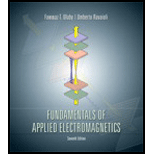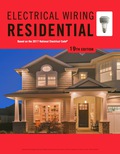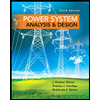
Fundamentals of Applied Electromagnetics (7th Edition)
7th Edition
ISBN: 9780133356816
Author: Fawwaz T. Ulaby, Umberto Ravaioli
Publisher: PEARSON
expand_more
expand_more
format_list_bulleted
Textbook Question
Chapter 4.11, Problem 28CQ
What is the fundamental premise of the image method?
Expert Solution & Answer
Want to see the full answer?
Check out a sample textbook solution
Students have asked these similar questions
help on this one?
a 1. What is the transpose system. What is the advantage of it.
2. What is the intersheath grading. What is the advantage of it.
3. What is the difference between redial and ring distribution system.
Please show all the steps!
Chapter 4 Solutions
Fundamentals of Applied Electromagnetics (7th Edition)
Ch. 4.2 - What happens to Maxwells equations under static...Ch. 4.2 - How is the current density J related to the volume...Ch. 4.2 - Prob. 3CQCh. 4.2 - A square plate residing in the xy plane is...Ch. 4.2 - A thick spherical shell centered at the origin...Ch. 4.3 - When characterizing the electrical permittivity of...Ch. 4.3 - If the electric field is zero at a given point in...Ch. 4.3 - State the principle of linear superposition as it...Ch. 4.3 - Four charges of 10 C each are located in free...Ch. 4.3 - Two identical charges are located on the x axis at...
Ch. 4.3 - In a hydrogen atom the electron and proton are...Ch. 4.3 - An infinite sheet with uniform surface charge...Ch. 4.4 - Explain Gausss law. Under what circumstances is it...Ch. 4.4 - How should one choose a Gaussian surface?Ch. 4.4 - Two infinite lines, each carrying a uniform charge...Ch. 4.4 - A thin spherical shell of radius a carries a...Ch. 4.4 - A spherical volume of radius a contains a uniform...Ch. 4.5 - What is a conservative field?Ch. 4.5 - Why is the electric potential at a point in space...Ch. 4.5 - Prob. 11CQCh. 4.5 - Why is it usually easier to compute V for a given...Ch. 4.5 - Prob. 13CQCh. 4.5 - Determine the electric potential at the origin due...Ch. 4.5 - A spherical shell of radius a has a uniform...Ch. 4.6 - What are the electromagnetic constitutive...Ch. 4.6 - Prob. 15CQCh. 4.6 - What is the conductivity of a perfect dielectric?Ch. 4.6 - Prob. 17CQCh. 4.6 - Prob. 18CQCh. 4.6 - Determine the density of free electrons in...Ch. 4.6 - Prob. 13ECh. 4.6 - A 50 m long copper wire has a circular cross...Ch. 4.6 - Prob. 15ECh. 4.7 - What is a polar material? A nonpolar material?Ch. 4.7 - Prob. 20CQCh. 4.7 - What happens when dielectric breakdown occurs?Ch. 4.7 - Find E1 in Fig. 4-19 if E2=x2y3+z3(v/m),1=20,2=80,...Ch. 4.7 - Repeat Exercise 4.16 for a boundary with surface...Ch. 4.8 - What are the boundary conditions for the electric...Ch. 4.8 - Prob. 23CQCh. 4.9 - How is the capacitance of a two-conductor...Ch. 4.9 - What are fringing fields and when may they be...Ch. 4.10 - To bring a charge q from infinity to a given point...Ch. 4.10 - Prob. 27CQCh. 4.10 - The radii of the inner and outer conductors of a...Ch. 4.11 - What is the fundamental premise of the image...Ch. 4.11 - Given a charge distribution, what are the various...Ch. 4.11 - Use the result of Example 4-13 to find the surface...Ch. 4 - A cube 2 m on a side is located in the first...Ch. 4 - Prob. 2PCh. 4 - Find the total charge contained in a round-top...Ch. 4 - If the line charge density is given by l = 24y2...Ch. 4 - Find the total charge on a circular disk defined...Ch. 4 - If J = 4xz (A/m2), find the current I flowing...Ch. 4 - Prob. 7PCh. 4 - An electron beam shaped like a circular cylinder...Ch. 4 - Prob. 9PCh. 4 - A line of charge of uniform density occupies a...Ch. 4 - A square with sides of 2 m has a charge of 40 C at...Ch. 4 - Three point charges, each with q = 3 nC, are...Ch. 4 - Charge q1 = 6 C is located at (1 cm, 1 cm, 0) and...Ch. 4 - A line of charge with uniform density = 8 (C/m)...Ch. 4 - Prob. 15PCh. 4 - A line of charge with uniform density l extends...Ch. 4 - Repeat Example 4-5 for liie circular disk of...Ch. 4 - Multiple charges at different locations are said...Ch. 4 - Three infinite lines of charge, all parallel to...Ch. 4 - Prob. 20PCh. 4 - A horizontal strip lying in the xy plane is of...Ch. 4 - Prob. 22PCh. 4 - Prob. 23PCh. 4 - Charge Q1 is uniformly distributed over a thin...Ch. 4 - The electric flux density inside a dielectric...Ch. 4 - Prob. 26PCh. 4 - An infinitely long cylindrical shell extending...Ch. 4 - If the charge density increases linearly with...Ch. 4 - A spherical shell with outer radius b surrounds a...Ch. 4 - Prob. 30PCh. 4 - Prob. 31PCh. 4 - A circular ring of charge of radius a lies in the...Ch. 4 - Prob. 33PCh. 4 - Find the electric potential V at a location a...Ch. 4 - For the electric dipole shown in Fig. 4-13, d = 1...Ch. 4 - For each of the distributions of the electric...Ch. 4 - Two infinite lines of charge, both parallel to the...Ch. 4 - Given the electric field E=R18R2(V/m) find the...Ch. 4 - An infinitely long line of charge with uniform...Ch. 4 - The xy plane contains a uniform sheet of charge...Ch. 4 - A cylindrical bar of silicon has a radius of 4 mm...Ch. 4 - Repeat Problem 4.41 for a bar of germanium with e...Ch. 4 - A 100 m long conductor of uniform cross-section...Ch. 4 - Prob. 44PCh. 4 - Apply the result of Problem 4.44 to find the...Ch. 4 - A 2 103 mm thick square sheet of aluminum has 5 cm...Ch. 4 - A cylinder-shaped carbon resistor is 8 cm in...Ch. 4 - With reference to Fig. 4-19, find E1 if...Ch. 4 - An infinitely long cylinder of radius a is...Ch. 4 - If E=R150(V/m) at the surface of a 5-cm conducting...Ch. 4 - Figure P4.51 shows three planar dielectric slabs...Ch. 4 - Determine the force of attraction in a...Ch. 4 - Dielectric breakdown occurs in a material whenever...Ch. 4 - An electron with charge Qe = 1.61019 C and mass me...Ch. 4 - In a dielectric medium with r = 4, the electric...Ch. 4 - Prob. 56PCh. 4 - Prob. 57PCh. 4 - Prob. 58PCh. 4 - Prob. 59PCh. 4 - Prob. 60PCh. 4 - Prob. 61PCh. 4 - Conducting wires above a conducting plane carry...Ch. 4 - Prob. 63P
Knowledge Booster
Learn more about
Need a deep-dive on the concept behind this application? Look no further. Learn more about this topic, electrical-engineering and related others by exploring similar questions and additional content below.Similar questions
- Please show all the steps!arrow_forward10-3) similar to Lathi & Ding, Prob. P.6.3-7 The Fourier transform P(f) of a the basic pulse p(t) used in a certain binary communication is shown in the figure below: P(f) 1 0.5 0 f₁ = 0.8 √₂ = 1.2 f, MHz (a) From the shape of P(f), explain at what pulse rate this pulse would satisfy Nyquist's first criterion. (b) Assuming that the pulse is a raised-cosine pulse, find its rolloff factor. (c) Find p(t) and verify that this pulse satisfies Nyquist's first criterion in the time domain. (d) Show how rapidly the pulse decays as a function of t, (i.e., what power of t does the envelope obey for large time values).arrow_forwardDon't use ai to answer I will report you answerarrow_forward
- Don't use ai to answer I will report you answerarrow_forwardDon't use ai to answer I will report you answerarrow_forwardChoose the correct answer for from the following sentences: 1. The purpose of the microprocessor is to control b. memory c. processing d. tasks a. switches 2. Which of the following instructions represents base-plus-index addressing mode? a. MOV AL,[BX] b. MOV AL,[SI] c. MOV AL,BX d. MOV AL,[BX+SI] 3. The BIU pre-fetches the instruction from memory and store them in b. memory c. stack d. queue a. register 4. Which function is used to control the PWM (Pulse Width Modulation) on the Arduino output pin? a. digitalRead() b. analogRead() c. digitalWrite() 5. Which port in the PIC16F877A has an 8 external interrupt inputs? a. Port-A b. Port-C c. Port-B d. analogWrite() d. Port-D d. 4KByte 6. How much Flash EEPROM memory program found in the PIC16F877A microcontroller? a. 32KByte b. 16KByte c. 8KBytearrow_forward
- Solve and select the correct answer: 2. For a random variable X with pdf: p(x) value of x is = 119 10 for -5≤x≤5. The mean (a) -75 (b) 10 (c) 0 (d) 75 3. Is the matrix A = = [1] orthogonal? Find the rank of A? 0 (a) YES, -1 (b) NO, 2 (c) YES, 2 (d) NO, -1 4. L{et sin(3t)u(t)) = (a) s-3 (s-2)²+9 2 (b) (5-3)² (c) (s-3)²+4 S-2 3 (s-2)²+9 (d) (5-2)²+9 = 5. Given that x is a constant. Choose all the correct solutions for [∞ (AB)] = (a) (AB)T (b) x ATBT (c) α BTAT (d) x (AB)Tarrow_forwardDO NOT WANT AI WILL REJECTarrow_forward3. Roughly sketch the root locus for the following locations of open-loop poles and zeros. You just need to show the shape of the root locus; you do not calculate the asymptote, break-in, and break-away points. ☑ (a) (b) ☑ Φ ① $3 (c)arrow_forward
arrow_back_ios
SEE MORE QUESTIONS
arrow_forward_ios
Recommended textbooks for you
 EBK ELECTRICAL WIRING RESIDENTIALElectrical EngineeringISBN:9781337516549Author:SimmonsPublisher:CENGAGE LEARNING - CONSIGNMENT
EBK ELECTRICAL WIRING RESIDENTIALElectrical EngineeringISBN:9781337516549Author:SimmonsPublisher:CENGAGE LEARNING - CONSIGNMENT Power System Analysis and Design (MindTap Course ...Electrical EngineeringISBN:9781305632134Author:J. Duncan Glover, Thomas Overbye, Mulukutla S. SarmaPublisher:Cengage Learning
Power System Analysis and Design (MindTap Course ...Electrical EngineeringISBN:9781305632134Author:J. Duncan Glover, Thomas Overbye, Mulukutla S. SarmaPublisher:Cengage Learning

EBK ELECTRICAL WIRING RESIDENTIAL
Electrical Engineering
ISBN:9781337516549
Author:Simmons
Publisher:CENGAGE LEARNING - CONSIGNMENT

Power System Analysis and Design (MindTap Course ...
Electrical Engineering
ISBN:9781305632134
Author:J. Duncan Glover, Thomas Overbye, Mulukutla S. Sarma
Publisher:Cengage Learning
Introduction to Logic Gates; Author: Computer Science;https://www.youtube.com/watch?v=fw-N9P38mi4;License: Standard youtube license